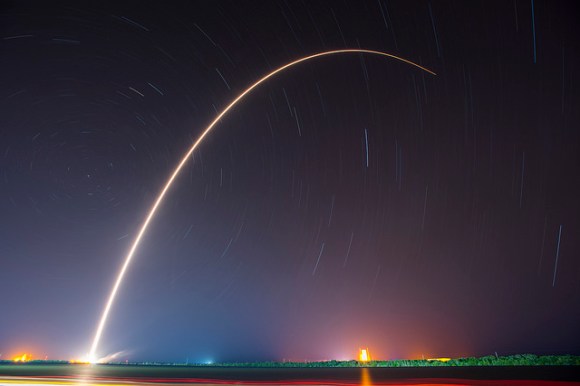
In addition to a second rocket landing at sea, SpaceX put a Japanese satellite in geosynchronous transfer orbit.
As you likely already know, SpaceX made news last night/early this morning when they successfully launched and landed a Falcon 9 rocket on a barge at sea. Their second successful recovery at sea and their third rocket landing overall, the landing elicited cheers from SpaceX employees and gleeful squeals of delight from people watching at home.
▼ And blew up Twitter with this photo.
Landing confirmed. Second stage continuing to carry JCSAT-14 to a Geosynchronous Transfer Orbit. pic.twitter.com/HfHI5cwoYX
— SpaceX (@SpaceX) May 6, 2016
Perhaps one of the biggest reason for the popularity of SpaceX is its openness to sharing copious amounts of dazzling videos and photos with the public. Sometimes it results in everyone getting to see one of their rockets explode as it tries to land, and other times it provides gorgeous images. After all, who could complain about something that looks this awesome?
▼ Feel free to make the “whooooosh” noises yourself.
But in all the excitement about the launch and landing of the Falcon 9 rocket, we started to wonder — just what was SpaceX putting into space?!
▼ Beside awesome photo opportunities.
The Falcon 9 second stage delivered JCSAT-14 to a Geosynchronous Transfer Orbit pic.twitter.com/GA5x9GMlgW
— SpaceX (@SpaceX) May 6, 2016
As it turns out, the satellite was JCSAT-14, a communications satellite owned by Tokyo-based telecommunications company SKY Perfect JSAT Corporation. The satellite is actually going to be replacing an older satellite and will be positioned in geosynchronous orbit so as to offer communications service to Japan and the Asia-Pacific region, including Russia and even Hawaii.
▼ But first, it rode off into the…sun?
The satellite weighed nearly 4,700 kilograms (about 10,360 pounds) at launch, a large part of which was fuel. Though SpaceX got the satellite to space, JCSAT-14 will “circularize” its orbit itself under its own power. Once testing is completed, the new satellite will begin operation and is expected to be in service for 15 years.
In case you missed the launch/landing/deployment live, you can watch it all with the YouTube clip below! It’s a bit long, though, so you may want to skip around a bit.
Fortunately, it looks like everyone was able to avoid the animated infighting we saw in the 2013 promotional video for NASA and JAXA’s DPR-equipped satellite. Though, if SpaceX is looking to hire some engineers from Japan, they should definitely consider taking a page from the JSDF recruitment book.
Sources: Twitter/SpaceX, SpaceX, SKY Perfect JSAT Corporation, SatBeams, NASA Space Flight, YouTube/SpaceX
Featured image: Flickr/SpaceX
Images: Twitter/SpaceX

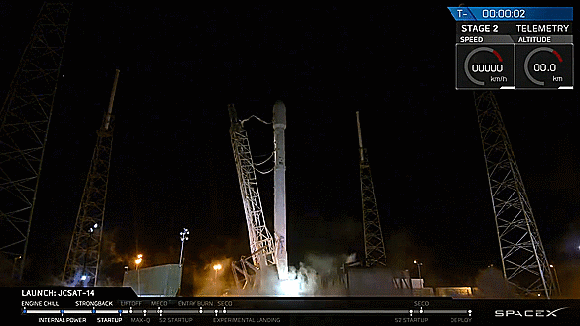
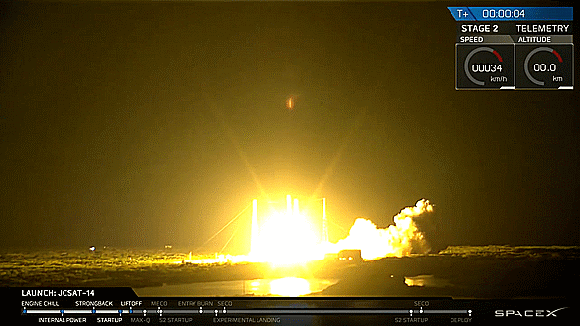
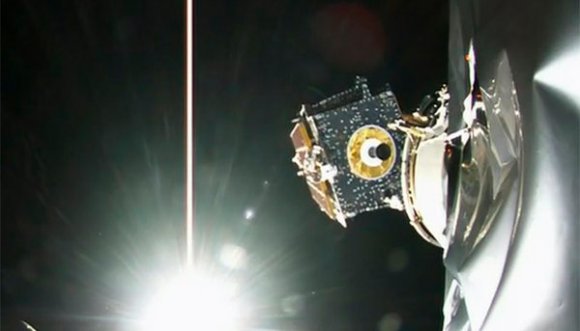
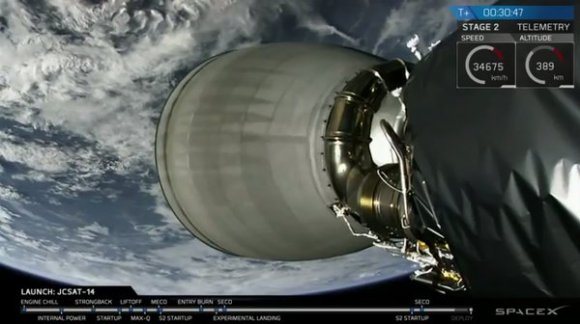
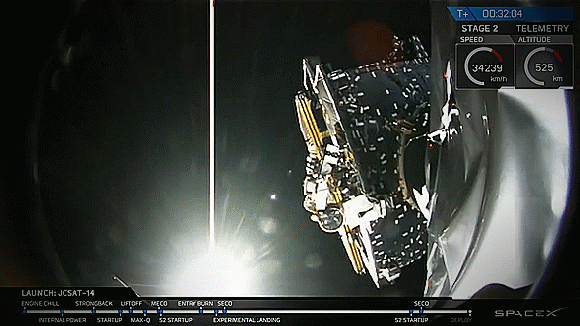
 Space One rocket explodes immediately after liftoff in Japan【Videos】
Space One rocket explodes immediately after liftoff in Japan【Videos】 Idols from the sea! Massive haul of idol singer photos wash up on Japanese coast【Photos】
Idols from the sea! Massive haul of idol singer photos wash up on Japanese coast【Photos】 World’s first artificial shooting stars gearing up for debut over Hiroshima
World’s first artificial shooting stars gearing up for debut over Hiroshima Japanese monks want to create new temple…in space!
Japanese monks want to create new temple…in space! How anyone with a computer can help search for the missing Malaysian airplane
How anyone with a computer can help search for the missing Malaysian airplane McDonald’s new Happy Meals offer up cute and practical Sanrio lifestyle goods
McDonald’s new Happy Meals offer up cute and practical Sanrio lifestyle goods All-you-can-drink Starbucks and amazing views part of Tokyo’s new 170 meter-high sky lounge
All-you-can-drink Starbucks and amazing views part of Tokyo’s new 170 meter-high sky lounge Studio Ghibli glasses cases let anime characters keep an eye on your spectacles
Studio Ghibli glasses cases let anime characters keep an eye on your spectacles Super Nintendo World expansion gets delayed for several months at Universal Studios Japan
Super Nintendo World expansion gets delayed for several months at Universal Studios Japan Beautiful Sailor Moon manhole cover coasters being given out for free by Tokyo tourist center
Beautiful Sailor Moon manhole cover coasters being given out for free by Tokyo tourist center The oldest tunnel in Japan is believed to be haunted, and strange things happen when we go there
The oldest tunnel in Japan is believed to be haunted, and strange things happen when we go there Pizza Hut’s new coriander pizza contains more cilantro than ever before!
Pizza Hut’s new coriander pizza contains more cilantro than ever before! Eating Japanese katsudon once served in police interrogation rooms
Eating Japanese katsudon once served in police interrogation rooms 10 of our absolute favorite places to spend a day in Tokyo
10 of our absolute favorite places to spend a day in Tokyo Want big breasts? Japanese cosplayer shows how to boost your bust in seconds
Want big breasts? Japanese cosplayer shows how to boost your bust in seconds Disney princesses get official manga makeovers for Manga Princess Cafe opening in Tokyo
Disney princesses get official manga makeovers for Manga Princess Cafe opening in Tokyo More foreign tourists than ever before in history visited Japan last month
More foreign tourists than ever before in history visited Japan last month Starbucks reopens at Shibuya Scramble Crossing with new look and design concept
Starbucks reopens at Shibuya Scramble Crossing with new look and design concept Beautiful new Final Fantasy T-shirt collection on the way from Uniqlo【Photos】
Beautiful new Final Fantasy T-shirt collection on the way from Uniqlo【Photos】 Is the new Shinkansen Train Desk ticket worth it?
Is the new Shinkansen Train Desk ticket worth it? Foreign English teachers in Japan pick their favorite Japanese-language phrases【Survey】
Foreign English teachers in Japan pick their favorite Japanese-language phrases【Survey】 Japanese convenience store packs a whole bento into an onigiri rice ball
Japanese convenience store packs a whole bento into an onigiri rice ball We try out “Chan Ramen”, an underground type of ramen popular in the ramen community
We try out “Chan Ramen”, an underground type of ramen popular in the ramen community Studio Ghibli releases Kiki’s Delivery Service chocolate cake pouches in Japan
Studio Ghibli releases Kiki’s Delivery Service chocolate cake pouches in Japan Japan’s bone-breaking and record-breaking roller coaster is permanently shutting down
Japan’s bone-breaking and record-breaking roller coaster is permanently shutting down New definition of “Japanese whiskey” goes into effect to prevent fakes from fooling overseas buyers
New definition of “Japanese whiskey” goes into effect to prevent fakes from fooling overseas buyers Our Japanese reporter visits Costco in the U.S., finds super American and very Japanese things
Our Japanese reporter visits Costco in the U.S., finds super American and very Japanese things Studio Ghibli unveils Mother’s Day gift set that captures the love in My Neighbour Totoro
Studio Ghibli unveils Mother’s Day gift set that captures the love in My Neighbour Totoro Foreign passenger shoves conductor on one of the last full runs for Japan’s Thunderbird train
Foreign passenger shoves conductor on one of the last full runs for Japan’s Thunderbird train Domino’s Japan now sells…pizza ears?
Domino’s Japan now sells…pizza ears? New Japanese KitKat flavour stars Sanrio characters, including Hello Kitty
New Japanese KitKat flavour stars Sanrio characters, including Hello Kitty Kyoto creates new for-tourist buses to address overtourism with higher prices, faster rides
Kyoto creates new for-tourist buses to address overtourism with higher prices, faster rides Sales of Japan’s most convenient train ticket/shopping payment cards suspended indefinitely
Sales of Japan’s most convenient train ticket/shopping payment cards suspended indefinitely Sold-out Studio Ghibli desktop humidifiers are back so Totoro can help you through the dry season
Sold-out Studio Ghibli desktop humidifiers are back so Totoro can help you through the dry season Japanese government to make first change to romanization spelling rules since the 1950s
Japanese government to make first change to romanization spelling rules since the 1950s Ghibli founders Toshio Suzuki and Hayao Miyazaki contribute to Japanese whisky Totoro label design
Ghibli founders Toshio Suzuki and Hayao Miyazaki contribute to Japanese whisky Totoro label design Doraemon found buried at sea as scene from 1993 anime becomes real life【Photos】
Doraemon found buried at sea as scene from 1993 anime becomes real life【Photos】 Tokyo’s most famous Starbucks is closed
Tokyo’s most famous Starbucks is closed One Piece characters’ nationalities revealed, but fans have mixed opinions
One Piece characters’ nationalities revealed, but fans have mixed opinions We asked a Uniqlo employee what four things we should buy and their suggestions didn’t disappoint
We asked a Uniqlo employee what four things we should buy and their suggestions didn’t disappoint Princesses, fruits, and blacksmiths: Study reveals the 30 most unusual family names in Japan
Princesses, fruits, and blacksmiths: Study reveals the 30 most unusual family names in Japan Artificial meteor showers a possibility for Tokyo Olympics opening ceremony
Artificial meteor showers a possibility for Tokyo Olympics opening ceremony 8 ways Kim Jong-Un has blindsided the US
8 ways Kim Jong-Un has blindsided the US Japanese masturbatory aid Tenga’s rocket project is a go, shaft will pierce the heavens soon【Video】
Japanese masturbatory aid Tenga’s rocket project is a go, shaft will pierce the heavens soon【Video】 Fear Factor meets Next Top Model in China’s modeling competition extravaganza
Fear Factor meets Next Top Model in China’s modeling competition extravaganza Get huge discounts on Japanese hotels… provided you’re a space alien (or claim to be one)
Get huge discounts on Japanese hotels… provided you’re a space alien (or claim to be one) Hackers to Gundam: 5 rumors about failed North Korean missile launch surface on Japanese Internet
Hackers to Gundam: 5 rumors about failed North Korean missile launch surface on Japanese Internet Trump’s announcement of America-Japan joint space exploration hypes up Japanese netizens
Trump’s announcement of America-Japan joint space exploration hypes up Japanese netizens Newsflash: Chinese satellite photos show “possible debris” from missing Malaysia Airlines plane
Newsflash: Chinese satellite photos show “possible debris” from missing Malaysia Airlines plane Egashira 2:50 denied ad revenue for YouTube channel
Egashira 2:50 denied ad revenue for YouTube channel Bill approving “Space Force” military branch moves forward in Japan’s parliament
Bill approving “Space Force” military branch moves forward in Japan’s parliament Chinese internet unusually upset by “most usual Chinese face” composite
Chinese internet unusually upset by “most usual Chinese face” composite Monster girl brothel anime gets kicked off of yet another Japanese TV station
Monster girl brothel anime gets kicked off of yet another Japanese TV station Team Rocket outlines recruitment project in Saga Prefecture
Team Rocket outlines recruitment project in Saga Prefecture Way to go! Japan earns top spot and two others in top 10 most dangerous world cities ranking
Way to go! Japan earns top spot and two others in top 10 most dangerous world cities ranking North Korea launches missiles into Japan Sea because it’s just that time again
North Korea launches missiles into Japan Sea because it’s just that time again Anime’s Tetsuwan Atom/Astro Boy shows up on a pedestrian walk signal in Japan
Anime’s Tetsuwan Atom/Astro Boy shows up on a pedestrian walk signal in Japan
Leave a Reply